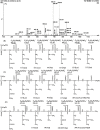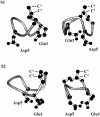Chemical structure, property and potential applications of biosurfactants produced by Bacillus subtilis in petroleum recovery and spill mitigation
- PMID: 25741767
- PMCID: PMC4394451
- DOI: 10.3390/ijms16034814
Chemical structure, property and potential applications of biosurfactants produced by Bacillus subtilis in petroleum recovery and spill mitigation
Abstract
Lipopeptides produced by microorganisms are one of the five major classes of biosurfactants known and they have received much attention from scientific and industrial communities due to their powerful interfacial and biological activities as well as environmentally friendly characteristics. Microbially produced lipopeptides are a series of chemical structural analogues of different families and, among them, 26 families covering about 90 lipopeptide compounds have been reported in the last two decades. This paper reviews the chemical structural characteristics and molecular behaviors of surfactin, one of the representative lipopeptides of the 26 families. In particular, two novel surfactin molecules isolated from cell-free cultures of Bacillus subtilis HSO121 are presented. Surfactins exhibit strong self-assembly ability to form sphere-like micelles and larger aggregates at very low concentrations. The amphipathic and surface properties of surfactins are related to the existence of the minor polar and major hydrophobic domains in the three 3-D conformations. In addition, the application potential of surfactin in bioremediation of oil spills and oil contaminants, and microbial enhanced oil recovery are discussed.
Figures








Similar articles
-
Structural Analysis of the Lipopeptide Produced by the Bacillus subtilis Mutant R2-104 with Mutagenesis.Appl Biochem Biotechnol. 2016 Jul;179(6):973-85. doi: 10.1007/s12010-016-2044-5. Epub 2016 Mar 28. Appl Biochem Biotechnol. 2016. PMID: 27020566
-
[Isolation and identification of surfactin producing Bacillus subtilis strain and its effect of surfactin on crude oil].Wei Sheng Wu Xue Bao. 2008 Mar;48(3):304-11. Wei Sheng Wu Xue Bao. 2008. PMID: 18479055 Chinese.
-
Production of surfactin and fengycin by Bacillus subtilis in a bubbleless membrane bioreactor.Appl Microbiol Biotechnol. 2010 Jun;87(2):499-507. doi: 10.1007/s00253-010-2504-8. Epub 2010 Mar 11. Appl Microbiol Biotechnol. 2010. PMID: 20221757
-
Lipopeptide surfactants: Production, recovery and pore forming capacity.Peptides. 2015 Sep;71:100-12. doi: 10.1016/j.peptides.2015.07.006. Epub 2015 Jul 17. Peptides. 2015. PMID: 26189973 Review.
-
Production of microbial biosurfactants: Status quo of rhamnolipid and surfactin towards large-scale production.Biotechnol J. 2017 Jul;12(7). doi: 10.1002/biot.201600561. Epub 2017 May 23. Biotechnol J. 2017. PMID: 28544628 Review.
Cited by
-
Diverse utilization of surfactants in coal-floatation for the sustainable development of clean coal production and environmental safety: a review.RSC Adv. 2022 Aug 24;12(37):23973-23988. doi: 10.1039/d2ra02861a. eCollection 2022 Aug 22. RSC Adv. 2022. PMID: 36093245 Free PMC article. Review.
-
Biosurfactants and Their Applications in the Oil and Gas Industry: Current State of Knowledge and Future Perspectives.Front Bioeng Biotechnol. 2021 Feb 15;9:626639. doi: 10.3389/fbioe.2021.626639. eCollection 2021. Front Bioeng Biotechnol. 2021. PMID: 33659240 Free PMC article. Review.
-
Surface-Active Compounds Produced by Microorganisms: Promising Molecules for the Development of Antimicrobial, Anti-Inflammatory, and Healing Agents.Antibiotics (Basel). 2022 Aug 16;11(8):1106. doi: 10.3390/antibiotics11081106. Antibiotics (Basel). 2022. PMID: 36009975 Free PMC article. Review.
-
Enhancing surfactin production in B. velezensis Bs916 combined cumulative mutagenesis and expression key enzymes.Appl Microbiol Biotechnol. 2023 Jul;107(13):4233-4244. doi: 10.1007/s00253-023-12590-5. Epub 2023 May 25. Appl Microbiol Biotechnol. 2023. PMID: 37231158
-
In vitro identification of antimicrobial hemolytic lipopeptide from halotolerant Bacillus by Zymogram, FTIR, and GC mass analysis.Iran J Basic Med Sci. 2021 May;24(5):666-674. doi: 10.22038/IJBMS.2021.53419.12022. Iran J Basic Med Sci. 2021. PMID: 34249269 Free PMC article.
References
-
- Deleu M., Razafindralambo H., Popineau Y., Jacques P., Thonart P., Paquot M. Interfacial and emulsifying properties of lipopeptides from Bacillus subtilis. Colloids Surf. Physicochem. Eng. Asp. 1999;152:3–10. doi: 10.1016/S0927-7757(98)00627-X. - DOI
-
- Grgurina I. Lipopeptide secondary metabolites from the phytopathogenic bacterium Pseudomonas syringae. In: Upadhyay R., editor. Advances in Microbial Toxin Research and Its Biotechnological Exploitation. Springer US; New York, NY, USA: 2002. pp. 105–140.
Publication types
MeSH terms
Substances
LinkOut - more resources
Full Text Sources
Other Literature Sources
Medical

